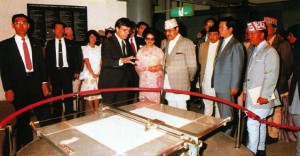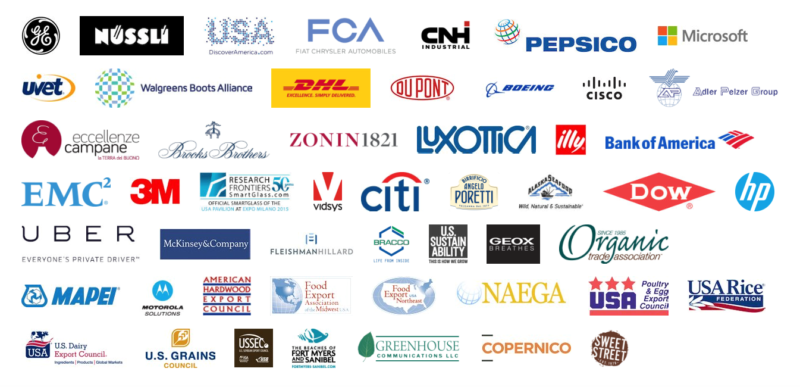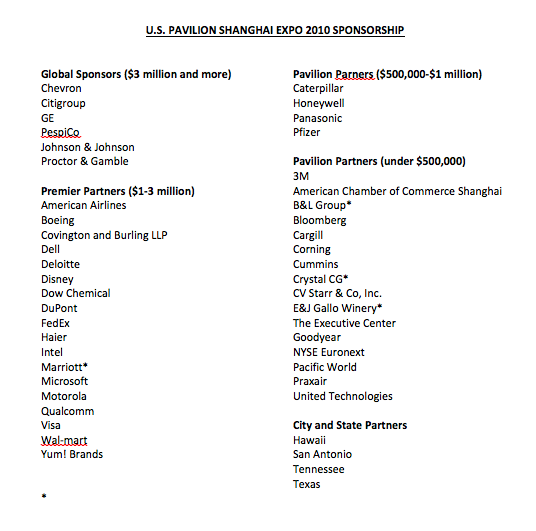
by James Ogul, author of Tales from the Expo
Image at top shows corporate sponsors for the USA Pavilion at Expo Milano 2015.
Over recent decades, the private sector role in USA Pavilions at world expos has evolved into something much more than just donating dollars. The current USA Pavilion at Milan Expo 2015 offers many examples. Whereas in prior years there might be branding and perhaps a corporate recognition day in the VIP lounge, today’s corporate sponsors of world expo pavilions are engaging in more hands-on partnership while actively spreading the word about their involvement and the reasons for it.
Dupont is a good example. The company’s Dupont Spotlight Twitter feed documents the company’s continuing involvement in the expo, which includes a lineup of guest speakers making live presentations to pavilion visitors. Dupont is also providing training programs for the Student Ambassadors that serve as guides for the USA Pavilion.
It’s a win-win situation. The USA Pavilion guest experience is enriched by relevant content that would otherwise not have been available and the corporations have the opportunity to represent themselves to the public in a way that shows their engagement with world issues at the heart of the expo theme – in the case of Milan, food security.
Microsoft provides another example with their Urban Farming program, documented in this article by Francisca Figueroa, a USA Pavilion Student Ambassador. As with Dupont, the extent of Microsoft’s support pays a dividend for both partners.
Many bemoaned the state of affairs when the U.S. Congress virtually blocked the possibility of Federal Funding for USA Pavilions with legislation in 1994 and later in 1999. I for one see that situation as having stimulated creative thinking that opened the door to better and richer USA Pavilions. The strength of a corporation partnering with the US on its official presence at a world exposition includes the influx and exchange of ideas and the latest in technology, as well as cash. This was seen at past USA Pavilions including Yeosu 2012 and Shanghai 2010.
The evolution from merely getting objects on loan from corporations, to taking cash donations, to naming parts of pavilions for corporations, to corporate messages on electronic billboards, to actual programmatic involvement and on-line corporate promotion of the USA Pavilion bodes well for further innovative ways in which Corporate America can play a key role in further USA Pavilions at worlds fairs.

How could the government role be enhanced?
On the Federal side of these partnerships, one major enhancement for the State Department (which manages U.S.participation in World’s Fairs) would be to create a permanent office to oversea these projects. In the past there was a World’s Fair Office in the United States Information Agency, which was folded into State, but that office was abolished in the early ’90s. While it existed, a core group of three or four people with hands-on world’s fair experience developed oversight expertise and kept records for each expo. This enabled them to apply lessons learned to future expos.
Here’s a possible scenario for how the US could revive something along those lines to boost its chances of successful participation in future world expos. The current approach to managing such involvement at the State Department is to have them run out of the Area Office covering the city where the expo is to be held. If a core world’s fair team of a few individuals such as described above could be established, they could be rotated to the area office handling the expo and bring their know-how with them: Everything from how to prepare an RFP for a pavilion, to how to go about the process of appointing a Commissioner General, to knowing which corporations have been enthusiastic past supporters, to knowing how to vet potential new sponsors. This would be an enormous help to these projects. Since the large-scale (Registered) world’s fairs happen every five years and the smaller ones (Recognized) happen between the larger ones, there would be ample work to keep the small, dedicated unit busy.







